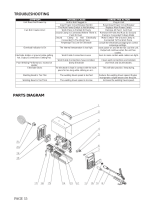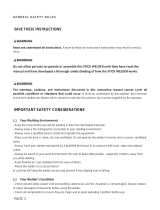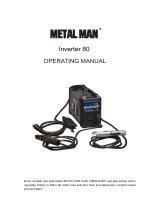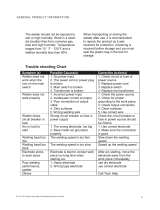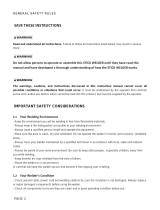Page is loading ...

POWERSTICK XXXKM
WARNING:
Read carefully and understand all
ASSEMBLY AND OPERATION
INSTRUCTIONS before operating.
Failure to follow the safety rules and
other basic safety precautions may
result in serious personal injury.
2015VERSION
OWNER’S MANUAL
WELDING AND CUTTING TOTAL SOLUTION

CATALOGUE
GENERAL SAFETY RULES
WARNING: Read and understand all instructions. Failure to follow
all instructions listed below may result in serious injury.
CAUTION: Do not allow persons to operate or assemble this
POWERSTICK series until they have read this manual and have developed
a thorough understanding of how the POWERSTICK series works.
WARNING: The warnings, cautions, and instructions discussed in
this instruction manual cannot cover all possible conditions or situations
that could occur. It must be understood by the operator that common sense and
GENERAL SAFETY RULES
DESCRIPTION
SPECIFICATIONS AND
DIMENSION
KNOW YOUR WELDER
INSTALLATION
OPERATION
TROUBLE SHOOTING CHART
MAIN CIRCUIT CHART

3
caution are factors which cannot be built into this product, but must be supplied
by the operator.
SAVE THESE INSTRUCTIONS
IMPORTANT SAFETY CONSIDERATIONS
1.1 Your Welding Environment
-Keep the environment you will be welding in free from flammable materials.
-Always keep a fire extinguisher accessible to your welding environment.
-Always have a qualified person install and operate this equipment.
-Make sure the area is clean, dry and ventilated. Do not operate the welder in
humid, wet or poorly ventilated areas.
-Always have your welder maintained by a qualified
technician in accordance
with local, state and national codes.
-Always be aware of your work environment. Be sure to keep other people,
especially children, away from you while welding.
-Keep harmful arc rays shielded from the view of others.
-Mount the welder on a secure bench
or cart that will keep the welder secure and prevent it from tipping over or falling.
1.2 Your Welder’s Condition
-Check ground cable, power cord and welding cable to be sure the insulation is
not damaged. Always replace or repair damaged components before using the
welder.
-Check all components to ensure they are clean and in good operating condition
before use.
1.3 Use of Your Welder
Do not operate the welder if the output cable, electrode, torch, wire or wire feed
system is wet. Do not immerse them in water. These components and the welder
must be completely dry before attempting to use them.
-Follow the instructions in this manual.
-Keep welder in the off position when not in use.
-Connect ground lead as close to the area being welded as possible to ensure a
good ground.
-Do not allow any body part to come in contact with the welding wire if you are in
contact with the material being welded, ground or electrode from another welder.
-Do not weld if you are in an awkward position. Always have a secure stance
while welding to prevent accidents. Wear a safety harness if working above
ground.
-Do not drape cables over or around your body.
-Wear a full coverage helmet with appropriate shade (see ANSI Z87.1 safety
standard) and safety glasses while welding.

4
-Wear proper gloves and protective clothing to prevent your skin from being
exposed to hot metals, UV and IR rays.
-Do not overuse or overheat your welder. Allow proper cooling time between duty
cycles.
-Keep hands and fingers away from moving parts and stay away from the drive
rolls.
-Do not point torch at any body part of yourself or anyone else.
-Always use this welder in the rated duty cycle to prevent excessive heat and
failure.
1.4 Specific Areas of Danger, Caution or Warning
Electrical Shock
Electric arc welders can produce a shock that can cause injury or
death. Touching electrically live parts can cause fatal shocks and
severe burns. While welding, all metal components connected to
the wire are electrically hot. Poor ground connections are a hazard, so secure the
ground lead before welding.
-Wear dry protective apparel: coat, shirt, gloves and insulated footwear.
-Insulate yourself from the work piece. Avoid contacting the work piece or
ground.
- Do not attempt to repair or maintain the welder while the power is on.
-Inspect all cables and cords for any exposed wire and replace immediately if
found.
-Use only recommended replacement cables and cords.
-Always attach ground clamp to the work piece or work table as close to the weld
area as possible.
-Do not touch the welding wire and the ground or grounded work piece at the
same time.
-Do not use a welder to thaw frozen pipes.
Fumes and Gases
-Fumes emitted from the welding process displace clean air and can result in
injury or death.
-Do not breathe in fumes emitted by the welding process. Make sure your
breathing air is clean and safe.
-Work only in a well-ventilated area or use a ventilation device to remove welding
fumes from the environment where you will be working.
-Do not weld on coated materials (galvanized, cadmium plated or containing zinc,
mercury or barium). They will emit harmful fumes that are dangerous to breathe.
If necessary use a ventilator, respirator with air supply or remove the coating
from the material in the weld area.
-The fumes emitted from some metals when heated are extremely toxic. Refer to
the material safety data sheet for the manufacturer’s instructions.
-Do not weld near materials that will emit toxic fumes when heated. Vapors from
cleaners, sprays and degreasers can be highly toxic when heated.
UV and IR Arc Rays

5
The welding arc produces ultraviolet (UV) and infrared (IR) rays that can cause
injury to your eyes and skin. Do not look at the welding arc without proper eye
protection.
-Always use a helmet that covers your full face from the neck to top of head and
to the back of each ear.
-Use a lens that meets ANSI standards and safety glasses. For welders under
160 Amps output, use a shade 10 lens; for above 160 Amps, use a shade 12.
Refer to the ANSI standard Z87.1 for more information.
-Cover all bare skin areas exposed to the arc with protective clothing and shoes.
Flame-retardant cloth or leather shirts, coats, pants or coveralls are available for
protection.
-Use screens or other barriers to protect other people from the arc rays emitted
from your welding.
-Warn people in your welding area when you are going to strike an arc so they
can protect themselves.
Fire Hazards
Do not weld on containers or pipes that contain or have had
flammable, gaseous or liquid combustibles in them. Welding creates
sparks and heat that can ignite flammable and explosive materials.
-Do not operate any electric arc welder in areas where flammable or explosive
materials are present.
-Remove all flammable materials within 35 feet of the welding arc. If removal is
not possible, tightly cover them with fireproof covers.
-Take precautions to ensure that flying sparks do not cause fires or explosions in
hidden areas, cracks or areas you cannot see.
-Keep a fire extinguisher close in the case of fire.
-Wear garments that are oil-free with no pockets or cuffs that will collect sparks.
-Do not have on your person any items that are combustible, such as lighters or
matches.
-Keep work lead connected as close to the weld area as possible to prevent any
unknown, unintended paths of electrical current from causing electrical shock
and fire hazards.
-To prevent any unintended arcs, cut wire back to ¼" stick out after welding.
Hot Materials
Welded materials are hot and can cause severe burns if handled
improperly.
-Do not touch welded materials with bare hands.
-Do not touch MIG gun nozzle after welding until it has had time to cool down.
Sparks/Flying Debris

6
Welding creates hot sparks that can cause injury. Chipping slag off welds creates
flying debris.
-Wear protective apparel at all times: ANSI-approved safety glasses or shield,
welder’s hat and ear plugs to keep sparks out of ears and hair.
Electromagnetic Field
-Electromagnetic fields can interfere with various electrical and
electronic devices such as pacemakers.
-Consult your doctor before using any electric arc welder or cutting
device
-Keep people with pacemakers away from your welding area when welding.
-Do not wrap cable around your body while welding.
-Wrap MIG gun and ground cable together whenever possible.
-Keep MIG gun and ground cables on the same side of your body.
Shielding Gas Cylinders Can Explode
High pressure cylinders can explode if damaged, so treat them
carefully.
-Never expose cylinders to high heat, sparks, open flames,
mechanical shocks or arcs.
-Do not touch cylinder with MIG gun.
-Do not weld on the cylinder
-Always secure cylinder upright to a cart or stationary object.
-Keep cylinders away from welding or electrical circuits.
-Use the proper regulators, gas hose and fittings for the specific application.
-Do not look into the valve when opening it.
-Use protective cylinder cap whenever possible
1.5 Proper Care, Maintenance and Repair
-Always have power disconnected when working on internal components.
- Do not touch or handle PC board without being properly grounded with a wrist
strap. Put PC board in static proof bag to move or ship.
-Do not put hands or fingers near moving parts such as drive rolls of fan
Description
The POWERSTICK series is a
DC inverter MMA welder . This
unit uses 1~Phase 110V/220V
50/60HZ AC power. A 16 amp
time delay fuse or circuit
breaker is recommended. The

7
POWERSTICK series is ideal for
Do-It-Yourself projects or for light
maintenance. Stick weld carbon
steel, stainless steel .
Unpacking
1.1 Remove cartons, bags or Styrofoam containing the welder and
accessories.
1.2 Check the contents with the packing list below.
ITEM QTY.
DC Inverter Arc Welder 1 unit
Welding cable with electrode holder 1pc
Grounding cable with earth clamp 1pc
Operator’s Manual 1set
1.3 After unpacking unit, inspect carefully for any
damage that may have occurred during transit. Check for loose, missing,
or damaged parts. Shipping damage claim must be filed with carrier.
Operating Instructions and Parts Manual
Specifications and Dimension

8
Removing from carton
1.1 Remove cartons, bags or Styrofoam containing the welder and accessories.
1.2 Check the contents with the packing list below.
Factory standard:EN60974-1
Optional accessories
:Protective mask、Hammer/brush、Electrod
Know your Welder
Description Specification
Model
POWERSTICK
140KM
POWERSTICK
160KM
POWERSTICK
200KM
Input power( V) 110V 220V 110V 2 20V 110V 220V
Frequency( Hz) 50/60
Rated input current
(A)
35 28 35 30 42 40
Rated input
capacitance( KVA)
3.9 6.1 3.9 6.6 4.6 8.8
No-load voltage(V)
78
Rated working
voltage( V)
24.4 25.6 24.4 26.4 25.2 28
welding current( A ) 15~110
15~140
15~110
15~160
15~130
15~200
Rated duty cycle( %
)
45 45 45 45 40 40
10min/100%( A) 74 94 74 107 82 126
Efficiency( η ) 85%
Power factor (Cos
φ )
0.75
Insulation class
H
Enclosure protection
(IP)
21S
Cooling type
Fan cooled
Dimension
(
cm
)
L×W×H
40*16*29
Weight(kg)
5.2 5.7
Power
Indicator

9
POWER INDICATOR
When the machine is turned on, the power indicator will be on.
ALARM INDICATOR
When the thermal indictor is on, it shows the machine is overloaded and the
internal temperature is too high.
Weld output will turn off automatically but the fan
will still be working. When the internal temperature is decreased, the overload
light will turn off and the machine will be ready to weld.
WELDING CURRENT
Welding Current is on the front panel of machine. It is an infinite current output
adjustment
WELDING CABLE
The welding cable are attached to electrode to complete the circuit, allowing the
flow of current needed to weld
GROUNDING CABLE
The ground cable/clamp are attached to the work piece to complete the circuit,
allowing the flow of current needed to weld
POWER SWITCH
In the “OFF” position no power is being supplied
In the “ON” position power is supplied to the main transformer and control circuit
POWER CORD
The power cord connects the welder to the110/ 220 volt power supply. 16 amp
receptacle to supply power to the welder.
Installtion
1. Power requirement
Power Cord
Power Switch
Welding
cable
Grounding
cable
Alarm
Indicator
Welding
Mode
Selector
Current
display
Welding
Current

10
AC single phase 110/220V, 50/60HZ fused with a 16amp time delayed
fuse or circuit breaker is required.
• The equipment class of POWERSTICK series DC Inverter Arc Welder
is class A.The class A equipment is not intended for use in residential
locations where the electrical power is provided by the public low-
voltage supply system.
• POWERSTICK series DC Inverter Arc Welder adopt the drooping
characteristic.
• POWERSTICK series DC Inverter Arc Welder is intended for use in the
independnet power system.
•High voltage danger from power source! Consult a qualified electrician
for proper installation of receptacle. This welder must be grounded while
in use to protect the operator from electrical shock.
• Do not remove grounding prong or alter the plug in any way. Do not
use any adapters between the welder’s power cord and the power
source receptacle. Make sure the POWER switch is OFF when
connecting your welder’s power cord to a properly grounded
110/220Vac, 50/60Hz, single phase, 16 amp power source.
2. Extension cord
During normal use an extension cord is not necessary. It is strongly
recommended that an extension cord should not be used because of the
voltage drop they produce. This drop in voltage can affect the
performance of the welder. If you need to use an extension cord it must
be a #12 gauge cord at the smallest.
-Do not use an extension cord over 25 ft. in length.
3. Setting up the work piece
3.1 Welding positions
There are two basic positions, for welding: Flat and Horizontal. Flat
welding is generally easier, faster, and allows for better penetration. If

11
possible, the work piece should be positioned so that the bead will run on
a flat surface.
3.2 Preparing the Joint
Before welding, the surface of work piece needs to be free of dirt, rust,
scale, oil or paint. Or it will create brittle and porous weld. If the base
metal pieces to be joined are thick or heavy, it may be necessary to
bevel the edges with a metal grinder. The correct bevel should be around
60 degrees.
See following picture:
Based on different welding position, there are different welding joint, see
following images for more information

12
4. Ground clamp connection
Clear any dirt, rust, scale, oil or paint on the ground clamp. Make certain
you have a good solid ground connection. A poor connection at the
ground clamp will waste power and heat. Make sure the ground clamp
touches the metal.
5. Electrode
The welding electrode is a rod coated with a layer of flux. When welding,
electrical current flows between the electrode (rod) and the grounded
metal work piece. The intense heat of the arc between the rod and the
grounded metal melts the electrode and the flux. The most popular
electrodes are:
-E6011 60,000 PSI tensile strength deep penetrating applications.
-E6013 60,000 PSI tensile strength used for poor fit up applications
-E7014 70,000 PSI tensile strength used for high deposition and fast
travel speeds with light penetration
-E7018 70,000 PSI tensile strength,
Used for out of position and tacking.
6. Selecting the proper electrode
There is no golden rule that determine the exact rod or heat setting
required for every situation. The type
and thickness of metal and the
position of the work piece determine
the electrode type and the amount of
heat needed in the welding process.
Heavier and thicker metals required
more amperage. It is best to practice
your welds on scrap metal which
matches the metal you intend to work
with to determine correct heat setting
and electrode choice. See following some helpful trouble shooting tips to
determine if you are using a correct electrod

13
1. When proper rod is used:
a. The bead will lay smoothly over the work without ragged edges
b. The base metal puddle will be as deep as the bead that rises above it
c. The welding operation will make a crackling sound similar to the sound
of eggs frying
2. When a rod too small is used
a. The bead will be high and irregular
b. The arc will be difficult to maintain
3. When the rod is too large
a. The arc will burn through light metals
b. The bead will undercut the work
c. The bead will be flat and porous
d. Rod may be freeze or stick to work piece
Note: Rate of travel over the work also affects the weld. To ensure
proper penetration and enough deposit of rod, the arc must be moved
slowly and evenly along the weld seam.
Operation
1.Setting the amperage control
The welder has an infinite output current control. It is capable of welding
with 1/16" and 5/64" and 3/32" electrodes.
here is no golden rule that determines the exact amperage required for
every situation. It is best to practice your welds on scrap metal which
matches the metals you intend to work with to determine correct setting
for your job. The electrode type and the thickness of the work piece
metal determine the amount of heat needed in the welding process.
Heavier and thicker metals require more voltage (amperage), whereas
lighter and thinner metals require less voltage (amperage).
2.Welding techniques
The best way to teach yourself how to weld is with short periods of
practice at regular intervals. All practice welds should be done on scrap
metal that can be discarded. Do not attempt to make any repairs on
valuable equipment until you have satisfied yourself that your practice
welds are of good appearance and free of slag or gas inclusions.
2.1 Holding the electrode
The best way to grip the electrode holder is the way that feels most
comfortable to you. To Position the Electrode to the work piece when
striking the initial arc it may be necessary to hold the electrode
perpendicular to the work piece. Once the arc is started the angle of the
electrode in relation to the work piece should be between 10 and 30
degrees. This will allow for good penetration, with minimal spatter.

14
2.2 Striking the arc
EXPOSURE TO A WELDING ARC IS EXTREMELY HARMFUL TO THE
EYES AND SKIN.
•Never strike an arc or begin welding until you have adequate protection.
• Wear flameproof welding gloves, heavy long-sleeved shirt, cuffless
trousers, high-topped shoes and a welding helmet or shield.
Scratch the work piece with the end of electrode to start arc and then
raise it quickly about 1/8 inch gap between the rod and the work piece.
See following picture
It is important that the gap be maintained during the welding process and
it should be neither too wide or too narrow. If too narrow, the rod will stick
to the work piece. If too wide, the arc will be extinguished. It needs much
practice to maintain the gap.Beginners may usually get sticking or arc
extinguishing. When the rod sticks to the work piece, gently rock it back
and forth to make them separate. If not, the circuit is short connection,
and it will overload the welder. A good arc is accompanied by a crisp,
cracking sound. The sound is similar to that made by eggs frying. To lay
a weld bead, only 2 movements are required; downward and in the
direction the weld is to be laid, as in following figure:
2.3 Types of weld bead
The following paragraphs discuss the most commonly used arc welding
beads.

15
The stringer bead Formed by traveling with the electrode in a straight line
while keeping it centered over the weld joint.
The weave bead Used when you want to deposit metal over a wider
space than would be possible with a stringer bead. It is made by weaving
from side to side while moving with the electrode. It is best to hesitate
momentarily at each side before weaving back the other way to improve
penetration.
2.4 Welding position
Flat position is the easiest of the welding positions and is most commonly
used. It is best if you can weld in the flat position if at all possible as good
results are easier to achieve.

16
The horizontal positionis is performed very much the same as the flat
weld except that the angle is different such that the electrode, and
therefore the arc force, is directed more toward the metal above the weld
joint. This more direct angle helps prevent the weld puddle from running
downward while still allowing slow enough travel speed to achieve good
penetration. A good starting point for your electrode angle is about 30
degrees DOWN from being perpendicular to the work piece.
2.5 Judge a good weld bead
When the trick of establishing and holding an arc has been learned, the
next step is learning how to run a good bead. The first attempts in
practice will probably fall short of acceptable weld beads. Too long of an
arc will be held or the travel speed will vary from slow to fast (see
following)
A. Weld speed is too fast.
B. Weld speed is too slow.
C. Arc is too long.
D. Ideal weld.
A solid weld bead requires that the electrode be moved slowly and
steadily along the weld seam. Moving the electrode rapidly or erratically
will prevent proper fusion or create a lumpy, uneven bead. To prevent

17
ELECTRIC SHOCK, do not perform any welding while standing,
kneeling, or lying directly on the grounded work.
2.6 Finish the bead
As the coating on the outside of the electrode burns off, it forms an
envelope of protective gasses around the weld. This prevents air from
reaching the molten metal and creating an undesirable chemical
reaction. The burning coating, however, forms slag. The slag formation
appears as an accumulation of dirty metal scale on the finished weld.
Slag should be removed by striking the weld with a chipping hammer.
7.TIG
7.1 ACCESORY
Tears off the main attaching plug,Turn off the power source,
The ground cable connect the positive electrode and screw it tighter,
The end of the ground cable connect the work piece,
The torch cable connect the cathode and screw it clockwise,
Tighter the gas tube bolt which connect the protection gas cylinder.
Inserts the main attaching plug
7.2 The touch pilot arc Warning! Turn on the power source , Welding
torch's
tungstic electrode already charged. The tungstic electrode could not
touch anything.this series welding machine TIG weld uses contact
striking the arc way;
Striking the arc method following step:
A.Turns on the welding torch built-in air valve
Approaches the striking the arc spot the spray nozzle to cause the
tungstic electrode and the work piece is separated 2~3mm

18
B.Slowly lifts the welding torch to cause the tungstic electrode contact
work piece
C.Lifts the welding torch to the normal position, starts to weld
Trouble shooting Chart
NO
Breakdown
Analysis
Solutions
1
Yellow
Indicator is on
Voltage is too high
(≥ 20%)
Switch off power source; Check
the main supply; Restart welder
when power recovers to normal
state.
Voltage is too low
(≤ 20%)
Bad power
ventilation lead to
over-heat protection
Improve the ventilation condition.
Circumstance
temperature is too
high.
It will automatically recover when
the temperature low down.
Using over the rated
duty-cycle.
It will automatically recover when
the temperature low down.

19
2
Cooling Fan
not working or
turning very
slowly
Switch broken Replace the switch
Fan broken Replace or repair the fan
Wire broken or
falling off
Check the connection
3
Arc is not
stable and
splash is
large
Too large contact tip
makes the current
unsteady
Change the proper contact tip or
roller
Too thin power
cable makes the
power astaticism
Change the power cable
Too low input
voltage
Enhance the input voltage
4
arc can’t be
pilot
Earth cable break Connect earth cable
Work piece has
much greasy dirty or
rusty stain
Clean greasy dirty or rusty stain
5
No shielded
gas
Torch is not
connected well
Connect the torch again
Gas pipe is pressed
or blocked up
Check gas system
Gas system rubber
pipe break
Connect gas system and bind
firmly
6 Others
Please connect with our company

20
Main Circuit chart
/
